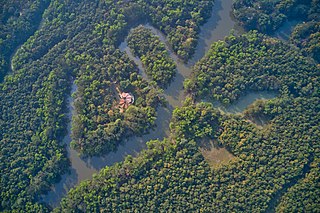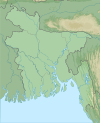
The Bengal tiger is a population of the Panthera tigris tigris subspecies and the nominate tiger subspecies. It ranks among the biggest wild cats alive today. It is considered to belong to the world's charismatic megafauna.

The fishing cat is a medium-sized wild cat of South and Southeast Asia. Since 2016, it is listed as Vulnerable on the IUCN Red List. Fishing cat populations are threatened by destruction of wetlands and have declined severely over the last decade. The fishing cat lives foremost in the vicinity of wetlands, along rivers, streams, oxbow lakes, in swamps, and mangroves.

The Ganges Delta is a river delta in Eastern South Asia predominantly covering the Bengal region of the subcontinent, consisting of Bangladesh and the Indian state of West Bengal. It is the world's largest river delta and it empties into the Bay of Bengal with the combined waters of several river systems, mainly those of the Brahmaputra river and the Ganges river. It is also one of the most fertile regions in the world, thus earning the nickname the Green Delta. The delta stretches from the Hooghly River east as far as the Meghna River.

The Sundarbans National Park is a national park, tiger reserve and biosphere reserve in West Bengal, India. It is part of the Sundarbans on the Ganges Delta and adjacent to the Sundarban Reserve Forest in Bangladesh. It is located to south-west of the Bangladesh. The delta is densely covered by mangrove forests, and is one of the largest reserves for the Bengal tiger. It is also home to a variety of bird, reptile and invertebrate species, including the salt-water crocodile. The present Sundarban National Park was declared as the core area of Sundarban Tiger Reserve in 1973 and a wildlife sanctuary in 1977. On 4 May 1984 it was declared a national park. It is a UNESCO World Heritage Site inscribed in 1987, and it has been designated as a Ramsar site since 2019. It is considered as a World Network of Biosphere Reserve from 1989.

Sundarbans is a mangrove area in the delta formed by the confluence of the Ganges, Brahmaputra and Meghna Rivers in the Bay of Bengal. Sundarban Reserve Forest (SRF) of Bangladesh is the largest mangrove forest in the world. It spans the area from the Baleswar River in Bangladesh's division of Khulna to the Hooghly River in India's state of West Bengal. It comprises closed and open mangrove forests, land used for agricultural purpose, mudflats and barren land, and is intersected by multiple tidal streams and channels. Sundarbans is home to the world's largest area of mangrove forests. Four protected areas in the Sundarbans are enlisted as UNESCO World Heritage Sites, viz. Sundarbans West (Bangladesh), Sundarbans South (Bangladesh), Sundarbans East (Bangladesh) and Sundarbans National Park (India).

The Pasur River is a river in southwestern Bangladesh and a distributary of the Ganges. It continues the Rupsa River. All its distributaries are tidal. It meets the Shibsa River within the Sundarbans, and near to the sea the river becomes the Kunga River. It is the deepest river in Bangladesh.
Ranthambore National Park is a national park in Rajasthan, India, with an area of 1,334 km2 (515 sq mi). It is bounded to the north by the Banas River and to the south by the Chambal River. It is named after the historic Ranthambore Fort, which lies within the park.

The Lower Gangetic Plains moist deciduous forests is a tropical and subtropical moist broadleaf forests ecoregion of Bangladesh and India. The ecoregion covers an area of 254,100 square kilometres (98,100 sq mi), comprising most of Bangladesh and the Indian states of West Bengal, Bihar and Tripura, and extending into adjacent states of Odisha, Uttar Pradesh and a tiny part of Assam, as well as adjacent western Myanmar.
Mukundara Hills National Park is a national park in Rajasthan, India with an area of 759.99 km2 (293.43 sq mi). It was established in 2004 and consists of three wildlife sanctuaries: Darrah Wildlife Sanctuary, National Chambal Sanctuary, and Jawahar Sagar Wildlife Sanctuary. It is located in the Khathiar-Gir dry deciduous forests.

Bethuadahari Wildlife Sanctuary is situated in the Bethuadahari town of Nadia District, West Bengal, India. The sanctuary is located beside National Highway 12. The sanctuary covers 67 hectares, and was established in 1980 to preserve a portion of the central Gangetic alluvial zone.
Sajnekhali Wildlife Sanctuary is a 362 km2 area in the northern part of the Sundarbans delta in South 24 Parganas district, West Bengal, India. It is located at the confluence of the Matla and Gumdi rivers. The area is mainly mangrove scrub, forest and swamp. It was set up as a sanctuary in 1976. It is home to a rich population of different species of wildlife, such as water fowl, heron, pelican, spotted deer, rhesus macaques, wild boar, tigers, water monitor lizards, fishing cats, otters, Olive ridley turtle, crocodiles, Batagur terrapins, and migratory birds. The ideal place for nature lovers to observe wild animals from a height is the Sajnekhali Watchtower.
The Haliday Island Wildlife Sanctuary is one of several wildlife sanctuaries in the nation of India. Located in the state of West Bengal, the area is approximately six square kilometers in size. It is a part of the 'Sundarbans Biosphere Reserve', with the Sundarbans region as a whole becoming a 'Biosphere Reserve' officially in 1989. The wildlife-heavy areas there are regarded as an environmentally-minded tourist destination.
India is home to a large variety of wildlife. It is a biodiversity hotspot with various ecosystems ranging from the Himalayas in the north to the evergreen rain forests in the south, the sands of the west to the marshy mangroves of the east. India lies within the Indomalayan realm and is the home to about 7.6% of mammal, 14.7% of amphibian, 6% of bird, 6.2% of reptilian, and 6.2% of flowering plant species. India's forests contain about 500 species of mammals and more than 2,000 bird species.

The wildlife of Pakistan comprises a diverse flora and fauna in a wide range of habitats from sea level to high elevation areas in the mountains, including 195 mammal, 668 bird species and more than 5000 species of Invertebrates. This diverse composition of the country's fauna is associated with its location in the transitional zone between two major zoogeographical regions, the Palearctic, and the Oriental. The northern regions of Pakistan, which include Khyber Pakhtunkhwa and Gilgit Baltistan include portions of two biodiversity hotspot, Mountains of Central Asia and Himalayas.

Sundarbans East Wildlife Sanctuary, a protected forest in Bangladesh, extends over an area of 31,227 ha. of mangrove forest. It was established in 1977 under the Bangladesh Wildlife (Preservation) (Amendment) Act, 1974, having previously been a forest reserve. It is the most fertile of the three, non-adjoining wildlife sanctuaries established in the Sundarbans at that time, the others being the Sundarbans West Wildlife Sanctuary and the Sundarbans South Wildlife Sanctuary. The dominant mangrove species is "sundri" from which the Sundarbans region gets its name.

Sundarbans West Wildlife Sanctuary is a UNESCO World Heritage Site and animal sanctuary in Bangladesh. The area of the reserve covers 715 km2. It is part of the larger Sundarbans region, one of the largest mangroveforests in the world. It is formed at the unified delta of the Ganges, Brahmaputra and Meghna rivers on the Bay of Bengal. The total area of the entire Sundarbans is about one million ha, 60% of which is found in Bangladesh, with the remainder 40% in India. The region is divided by the Raimangal River. Within the Bangladeshi area of Sundarbans, there are three wildlife sanctuaries: Sundarbans East, Sundarbans South, and Sundarbans West.

West Bengal is a state in the eastern region of India and is the nation's fourth-most populous. The state capital is Kolkata. The state encompasses two broad natural regions: the Gangetic Plain in the south and the sub-Himalayan and Himalayan area in the north. The tourism in West Bengal is maintained by WBTDCL, a state government owned enterprise.













